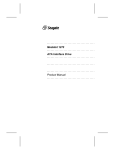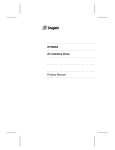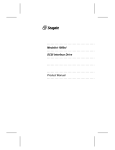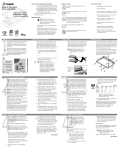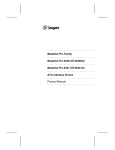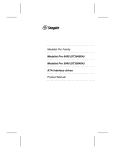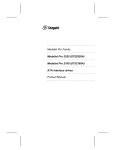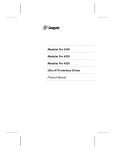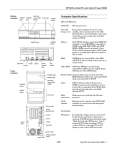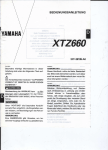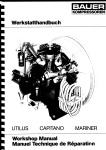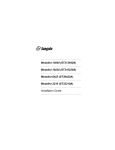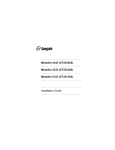Download Seagate Medalist SL Family Product manual
Transcript
..................................... Medalist SL Family ..................................... Medalist 540sl, Medalist 851sl ...... .............................. Medalist 1080sl, Medalist 1270sl ..................................... ATA Interface Drives ..................................... Product Manual ..................................... ..................................... Medalist SL Family ..................................... Medalist 540sl, Medalist 851sl ..................................... Medalist 1080sl, Medalist 1270sl ..................................... ATA Interface Drives ..................................... Product Manual ..................................... 4 Medalist SL Family Product Manual, June 1996 © 1996 Seagate Technology, Inc. All rights reserved Publication Number: 36331-301, Rev. A, June 1996 Supersedes Publication Numbers 36331-1xx and 36304-xxx Seagate, Seagate Technology and the Seagate logo are registered trademarks of Seagate Technology, Inc. Medalist is a trademark of Seagate Technology, Inc. Other product names are trademarks or registered trademarks of their owners. Seagate reserves the right to change, without notice, product offerings or specifications. No part of this publication may be reproduced in any form without written permission from Seagate Technology, Inc. Medalist SL Family Product Manual, June 1996 iii Contents Introduction . . . . . . . . . . . . . . . . . . . . . . . . . . . . . 1 Quick specification chart . . . . . . . . . . . . . . . . . . . . . . 3 1.0 Specifications . . . . . . . . . . . . . . . . . . . . . . . . . . 5 1.1 Formatted capacity . . . . . . . . . . . . . . . . . . . . . . . 5 1.1.1 Standard configuration . . . . . . . . . . . . . . . . . . 5 1.1.2 Physical organization . . . . . . . . . . . . . . . . . . . 6 1.2 Functional specifications . . . . . . . . . . . . . . . . . . . . 7 1.3 Physical dimensions . . . . . . . . . . . . . . . . . . . . . . 7 1.4 Seek time . . . . . . . . . . . . . . . . . . . . . . . . . . . . 7 1.5 Start and stop times . . . . . . . . . . . . . . . . . . . . . . 8 1.6 Typical power-up and power-down sequence . . . . . . . . . 8 1.6.1 Power-up sequence . . . . . . . . . . . . . . . . . . . . 8 1.6.2 Power-down sequence . . . . . . . . . . . . . . . . . . 9 1.6.3 Auto-park . . . . . . . . . . . . . . . . . . . . . . . . . 9 1.7 Power specifications . . . . . . . . . . . . . . . . . . . . . 10 1.7.1 Power consumption . . . . . . . . . . . . . . . . . . . 10 1.7.2 Voltage tolerance . . . . . . . . . . . . . . . . . . . . 11 1.7.3 Input noise . . . . . . . . . . . . . . . . . . . . . . . . 12 1.8 Environmental specifications . . . . . . . . . . . . . . . . . 12 1.8.1 Ambient temperature . . . . . . . . . . . . . . . . . . 12 1.8.2 Temperature gradient . . . . . . . . . . . . . . . . . . 12 1.8.3 Altitude . . . . . . . . . . . . . . . . . . . . . . . . . 12 1.8.4 Relative humidity . . . . . . . . . . . . . . . . . . . . 12 1.8.5 Shock and vibration . . . . . . . . . . . . . . . . . . . 13 1.9 Acoustics . . . . . . . . . . . . . . . . . . . . . . . . . . . 14 1.10 Reliability . . . . . . . . . . . . . . . . . . . . . . . . . . 14 1.11 Agency listings . . . . . . . . . . . . . . . . . . . . . . . 15 1.12 FCC verification . . . . . . . . . . . . . . . . . . . . . . . 15 iv Medalist SL Family Product Manual, June 1996 2.0 Configuring and mounting the drive . . . . . . . . . . . . . 17 2.1 Handling and static-discharge precautions 2.2 I/O connector . . . . . . . . . 17 . . . . . . . . . . . . . . . . . . . . . . . . 18 2.3 Options jumper block . . . . . . . . . . . . . . . . . . . . . 18 2.3.1 Master/slave configuration . . . . . . . . . . . . . . . 21 2.3.2 Master/slave timing compatibility . . . . . . . . . . . . 21 2.3.3 Remote LED connection . . . . . . . . . . . . . . . . 21 2.3.4 Cable-select option . . . . . . . . . . . . . . . . . . . 22 2.4 Mounting the drive . . . . . . . . . . . . . . . . . . . . . . 23 3.0 ATA interface . . . . . . . . . . . . . . . . . . . . . . . . . . 25 3.1 ATA interface connector pin assignments . . . . . . . . . . 25 3.2 Command set . . . . . . . . . . . . . . . . . . . . . . . . 27 3.2.1 Identify Drive command (ECH) . . . . . . . . . . . . . 29 3.2.2 Set Features command (EFH) . . . . . . . . . . . . . . 31 3.2.3 Idle and Set Idle Timer (FAH) . . . . . . . . . . . . . . 33 3.2.4 Active and Set Idle Timer command (FBH) . . . . . . . 34 3.2.5 Auto Relocation . . . . . . . . . . . . . . . . . . . . . 34 3.2.6 Execute S.M.A.R.T. Function command (B0H) . . . . . 34 Appendix. Timing diagrams . . . . . . . . . . . . . . . . . . . . 35 Medalist SL Family Product Manual, June 1996 v Figures Figure 1. Typical +12V startup current profile . . . . . . . . . . . . Figure 2. ATA interface connector 8 . . . . . . . . . . . . . . . . . 18 Figure 3. Drive connectors . . . . . . . . . . . . . . . . . . . . . 19 Figure 4. Options jumper block settings . . . . . . . . . . . . . . . 20 Figure 5. Connecting cable-selected drives . . . . . . . . . . . . . 22 Figure 6. Mounting dimensions . . . . . . . . . . . . . . . . . . . 24 Figure 7. ATA interface connector pin assignments . . . . . . . . 26 Figure 8. Programmed I/O timing without IORDY . . . . . . . . . . 35 Figure 9. Programmed I/O timing with IORDY . . . . . . . . . . . 36 Figure 10. Multiword DMA timing . . . . . . . . . . . . . . . . . . 37 Medalist SL Family Product Manual, June 1996 1 Introduction This manual describes the functional, mechanical and interface specifications for the Medalist 540sl, 851sl, 1080sl and 1270sl hard disc drives. The drives are referred to throughout this manual by their model numbers: ST5540A for the Medalist 540sl, ST5851A for the Medalist 851sl, ST51080A for the Medalist 1080sl and ST51270A for the Medalist 1270sl. The drives combine features used in the Decathlon drives, such as Fast ATA-2 capability, 5,376-RPM spindle speed, embedded servo and the mini 3.5-inch footprint with new technology and more cost-efficient design to provide high performance, high capacity, low noise, energy-efficiency and superior value. The drives are designed to ensure fast data-throughput between the drive and the host. Fast ATA-2 capability means that the drives support PIO mode 4 and multiword DMA mode 2 and multiple block read/write. When the host chooses PIO mode 4 or multiword DMA mode 2, the drives respond with burst data-transfer rates of up to 16.6 Mbytes per second. Multiple block read/write allows the drive to gather several blocks of data in cache and transfers them in a single burst. Other features the drives have that promote fast data-throughput include embedded servo technology to ensure quick and accurate access to information on the drive without thermal recalibration interruptions, a 16-bit internal microprocessor and an intelligent controller that provides data streaming—direct data transfers between the host and the drive without microprocessor intervention. These features increase the sustained data-transfer rate, facilitating video playback and other multimedia operations. Coupled with the 854-Mbyte capacity of the ST5851A, the 1.08-Gbyte capacity of the ST51080A and the 1.28 Gbytes of the ST51270A (more than enough capacity to download a complete CDROM), these features make true multimedia-ready drives. The drives support the power modes defined in the ATA-2 standard. Standby and Sleep modes reduce power consumption to a low 0.5 watts (typical). The drives enter power-saving modes at the request of the computer and can be programmed to automatically enter Idle or Standby modes. (A complete listing of the ATA commands the drives support is found in the table on page 27. The ATA commands that have Seagateunique applications and the Seagate-unique commands the drives use are discussed in Section 3.0 on page 25.) The drives are designed for the standard 3.5-inch footprint but have a slim 0.75-inch high (19-mm) profile and a shorter 5.0-inch depth profile. Even though the overall size of the drives is reduced, the top and bottom mounting holes are placed in strict compliance with the SFF committee standards for the 3.5-inch form-factor. This size reduction gives the 2 Medalist SL Family Product Manual, June 1996 designer or integrator more room for air circulation, other peripherals or a smaller drive bay. In addition, the smaller size and a redesigned top cover have improved the acoustics for the 5,376-RPM drive. The idle acoustic sound level is 30 dBA. The following is a summary of the drives’ features: Capacity • 540, 854, 1,080 and 1,282 Mbytes formatted • One-disc and two-disc formats • LBA translation support Performance • Fast ATA-2. (Supports multiword DMA modes 0, 1, 2 and PIO modes 0, 1, 2, 3 and 4 for up to 16.6-Mbyte-per-second transfer rates. Supports multiple block read/write.) • 5,376-RPM rotational speed • 128-Kbyte segmented buffer • 10.5-msec average seek time • 16-bit microprocessor • Data streaming Energy efficiency • Supports ATA-2 power-management modes: Active, Idle, Standby and Sleep • 0.5 watt typical power dissipation rating in Standby and Sleep modes Acoustics • 30-dBA idle acoustic sound level Medalist SL Family Product Manual, June 1996 3 Quick specification chart The following table serves as a quick reference of performance specifications for these drives. These and other specifications are discussed in the Specification summary section following the table. Drive specification Guaranteed capacity (Mbytes) (×106 bytes) Guaranteed sectors ST5540A 541.9 ST5851A ST51080A ST51270A 854.7 1,083.8 1,058,400 1,669,248 2,116,800 1,282.4 2,504,880 Bytes per sector 512 512 512 512 Logical cylinders 1,050 1,656 2,100 2,485 Sectors per track 63 63 63 63 Logical read/write heads 16 16 16 16 Physical read/write heads 2 4 4 4 Physical discs 1 2 2 2 4,834 4,834 4,834 5,414 Physical cylinders Recording density (Kbits per inch) 76.2 76.2 76.2 79.2 Track density (tracks per inch) 4,800 4,800 4,800 5,376 34.5 to 67.7 34.5 to 67.7 34.5 to 67.7 36.1 to 71.4 Internal data-transfer rate (Mbits per sec max) Spindle speed (RPM) 5,376 Average latency (msec) 5.58 Track-to-track seek time (msec typical) 2.0 Average seek time (msec typical) 10.5 Full-stroke seek time (msec typical) 20.0 Ext. transfer rate1 (Mbytes per sec) PIO mode 4 16.6 Ext. transfer rate1 (Mbytes per sec) DMA mode 2 16.6 Cache buffer (Kbytes) 128 Height, inches max (mm) 0.748 (19.0) Width, inches max (mm) 4.01 (101.9) Depth, inches max (mm) 5.01 (127.3) Typical weight, lb (g) 0.750 (340.2) continued 1. External transfer rates are based on the ATA-2 standard. Actual performance may exceed the standard. See your Seagate® representative for details. 4 Medalist SL Family Product Manual, June 1996 continued from previous page Drive specification Power-on to ready (sec typical) Spinup current (typical) ST5540A ST5851A ST51080A ST51270A 8 1.1A Seek power (typical) 6.52W Read/Write power and current (typical) 4.9W Idle total power (typical) 3.36W Standby/Sleep total power (typical) 0.71W Voltage tolerance (including noise): +5V ±5% Voltage tolerance (including noise): +12V ±5% Operating temperature (°C) 5° to 55°C Nonoperating temperature (°C) –40° to 70°C Operating temperature gradient (°C per hour max) 20°C Relative humidity, operating gradient (max) 10% per hour Altitude operating –1,000 to 10,000 ft. Altitude nonoperating –1,000 to 40,000 ft. Shock, normal operating (Gs max for 11 msec) 2 Gs Shock, abnormal operating (Gs max for 11 msec) 10 Gs Shock, nonoperating (Gs max) 75 Gs Vibration (Gs max at 22–350 Hz without nonrecoverable errors), operating 0.75 Gs 0 to Peak Vibration (Gs max at 22–350 Hz with no physical damage incurred), nonoperating 4 Gs 0 to Peak Drive acoustics, Idle mode (dBA) 30 dBA Drive acoustics, seeking (dBA) 34 dBA Nonrecoverable read errors (per bits transferred) 1013 Mean time between failures (poweron hours) 300,000 Contact start-stop cycles 40,000 Service life (years) 5 Medalist SL Family Product Manual, June 1996 5 1.0 Specifications Unless otherwise noted, all specifications are measured under ambient conditions, at 25°C, at sea level and nominal power. 1.1 Formatted capacity Medalist SL drives are low-level formatted at the factory. You cannot low-level format them. You can operate the drive using many different address configurations, provided the number of sectors per track does not exceed 63. The following tables show CHS and LBA translation geometries for the standard configurations. You can verify the parameters using the Identify Drive (ECH) command. 1.1.1 Standard configuration ST5540A CHS LBA Cylinders 1,050 N/A Heads 16 N/A Sectors 63 N/A 1,058,400 1,058,400 Guaranteed capacity (bytes ) 541,900,800 541,900,800 ST5851A CHS LBA Cylinders 1,656 N/A Heads 16 N/A Sectors 63 N/A 1,669,248 1,669,248 854,654,976 854,654,976 Guaranteed sectors 2 Guaranteed sectors 2 Guaranteed capacity (bytes ) 2. One Mbyte equals one million bytes. 6 Medalist SL Family Product Manual, June 1996 ST51080A CHS LBA Cylinders 2,100 N/A Heads 16 N/A Sectors 63 N/A 2,116,800 2,116,800 Guaranteed capacity (bytes ) 1,083,801,600 1,083,801,600 ST51270A CHS LBA Cylinders 2,485 N/A Heads 16 N/A Sectors 63 N/A 2,504,880 2,504,880 1,282,498,560 1,282,498,560 Guaranteed sectors 2 Guaranteed sectors 2 Guaranteed capacity (bytes ) 1.1.2 Physical organization ST5540A ST5851A ST51080A ST51270A Read/write heads 2 4 4 4 Discs 1 2 2 2 Medalist SL Family Product Manual, June 1996 7 1.2 Functional specifications ST5540A ST5851A ST51080A ST51270A Model ATA-2 Interface RLL (1,7) Zone Bit Recording method External data burst-transfer rate: 16.6 Mbytes per sec DMA mode 23 16.6 Mbytes per sec PIO mode 44 Internal data-transfer rate (Mbits per sec) 34.5 36.1 Inner track 67.7 74.1 Outer track 4,834 5,414 Physical cylinders 512 512 Bytes per sector 76.2 79.2 Recording density, max (KBPI) 4,800 5,376 Track density (TPI) 5,376 ± 0.5% Spindle speed (RPM) 128 Cache size (Kbytes) 1.3 Physical dimensions The mounting dimensions are shown in Figure 6 on page 24. Height, max 0.748 inches (19.0 mm) Width, max 4.01 inches (101.9 mm) Depth, max 5.01 inches (127.3 mm) Weight 0.750 lb (340.2 g) 1.4 Seek time Seek time is the interval between the time the actuator begins to move and the time the head is over the target track. Seek time is a true statistical average of at least 10,000 measurements of seek time. All measurements for maximum values are taken under nominal conditions of temperature and voltage with the drive mounted horizontally. 3. See Figure 10 on page 37 for timing specifications. 4. See Figure 9 on page 36 for timing specifications. 8 Medalist SL Family Product Manual, June 1996 The specifications in the table below are defined as follows: • Track-to-track seek time is the average of all possible single-track seeks in both directions. • Average seek time is measured by executing seeks in both directions between random cylinders. • Full-stroke seek time is half the time needed to seek from track 0 to the maximum track and back to track 0. Track-to-track seek time Average/typical seek time Full-stroke seek time Average latency 2.0 msec typ 10.5 msec 20.0 msec typ 5.58 msec Note. Host overhead varies between systems and cannot be specified. Drive internal overhead is measured by issuing a no-motion seek. Overhead is typically less than 1.0 msec. 1.5 Start and stop times The drive is ready within 8 seconds after the power is applied. The drive spindle stops rotating within 7 seconds typical after the power is removed. 1.6 Typical power-up and power-down sequence A typical power-up and power-down sequence is described below to assist you in evaluating the drive. It is not a specification. 1.6.1 Power-up sequence 1. Power is applied to the drive. 2. After a delay, the startup current is applied and the spindle begins to turn. 3. The accelerating current is applied, causing the spindle speed to increase. 4. The spindle speed is close to the final correct value. The drive begins to lock in speed-control circuits. 5. The arm-lock mechanism releases the arm. 6. The final speed control lock is achieved. 7. The heads are positioned over track 0 and the drive has completed its power-up sequence. Medalist SL Family Product Manual, June 1996 9 Milliamps 1,200 1,000 800 600 400 200 0 0 1 2 3 4 5 6 7 8 Seconds Figure 1. Typical +12V startup current profile 1.6.2 Power-down sequence Caution. Do not move the drive until the motor has come to a complete stop. 1. The power is turned off. 2. Within 3 seconds, the motor begins to spin down. 3. The read/write heads automatically move to the landing zone, a designated area beyond the maximum data cylinder. 4. The actuator-lock mechanism locks the arm. This completes the power-down sequence. 1.6.3 Auto-park Upon power-down, the read/write heads automatically move to the landing zone. The heads park beyond the maximum data cylinder and the actuator-lock mechanism locks the arm. When power is applied, the heads recalibrate to track 0. 10 Medalist SL Family Product Manual, June 1996 1.7 Power specifications 1.7.1 Power consumption The drives support Active, Idle, Standby and Sleep power-management modes. The power-management commands the drives support are listed in the table on page 27. The table below shows the average typical power consumption rates for each power-management mode. Each mode is defined in the section following the table. All measurements were taken at the drive’s power connector. A true RMS meter is used to measure all modes except Standby. A DMM is used for Standby measurements. Read/ Spinup Seeking write Idle Standby Current at +12V Amps peak 1.100 — — — — RMS amps typ 0.635 0.385 0.242 0.220 0.019 Watts typ 7.62 4.62 2.90 2.64 0.23 RMS amps typ 0.266 0.380 0.400 0.143 0.096 Watts typ 1.33 1.90 2.00 0.72 0.48 8.95 6.52 4.90 3.36 0.71 Current at +5V Power Total watts typ 1.7.1.1 Active mode During the Active mode, the drive is involved in spinup, seeking or read/write activities. • Spinup. Spinup mode is entered from the Standby mode. The drive brings the spindle and discs up to operating speed. Power in this mode is measured from power-on to the time the drive is ready for normal operation. • Seeking. Seek mode is entered from Idle mode. The read/write heads are moved to a specific location on the disc surface in preparation for reading from or writing to the disc. Typical power is defined as the power average of executing random seeks with a 2-revolution (22.2 msec) dwell between Seek commands. Medalist SL Family Product Manual, June 1996 11 • Read/write. Read/write power and current are measured with the heads on track. The test cycle consists of writing 16 sectors followed by a 22.2 msec delay and reading 16 sectors followed by a 22.2 msec delay. 1.7.1.2 Idle mode The motor is up to speed, the servo electronics are inactive and the heads are in the landing zone. A time delay is encountered when executing a command that requires disc access. The drive enters Idle mode when the host issues an Idle command, Idle Immediate command or Idle and Set Idle Timer command. The Idle timer is a Seagate-unique feature and is disabled by the factory. It is discussed in Section 3.2.3 on page 33. 1.7.1.3 Standby mode Standby mode is entered from the Idle mode. The drive is fully operational through the interface and accepts commands, but a latency occurs if any command received requires disc access or actuator movement. In Standby mode, the spindle is stopped, the heads are parked in the landing zone, the actuator is latched and some of the drive electronics are powered down. 1.7.1.4 Sleep mode The spindle is stopped, the heads are parked in the landing zone, the actuator is latched, and the interface and some of the drive electronics are powered down. The drive exits sleep mode when the computer issues a hard or soft reset. The drive returns to Standby mode when the computer issues a soft reset. 1.7.2 Voltage tolerance Voltage tolerance (including noise) +5V +12V ± 5% ± 5% 12 1.7.3 Medalist SL Family Product Manual, June 1996 Input noise +5V +12V Input noise frequency (max) 25 MHz 25 MHz Input noise (max, peak-to-peak) 100 mV 240 mV 1.8 Environmental specifications 1.8.1 Ambient temperature Operating Nonoperating 1.8.2 Temperature gradient Operating Nonoperating 1.8.3 5° to 55°C (41° to 131°F) –40° to 70°C (–40° to 158°F) 20°C per hour (36°F per hour) 30°C per hour (54°F per hour) Altitude Operating –1,000 to 10,000 ft (–305 to 3,048 m) Nonoperating –1,000 to 40,000 ft (–305 to 12,192 m) 1.8.4 Relative humidity Operating Maximum operating gradient Nonoperating 8% to 80% noncondensing Maximum wet bulb 29.4°C (84.9°F) 10% per hour 5% to 95% noncondensing Maximum wet bulb 35.0°C (95.0°F) Medalist SL Family Product Manual, June 1996 1.8.5 13 Shock and vibration The drive is mounted for normal operation as recommended in Section 2.4 on page 23. Shock and vibration may be applied in the X, Y or Z axis. Episodes are not repeated more than twice per second. The shock and vibration limits specified in this document are measured directly on the chassis. If the drive is installed in an enclosure to which the shock or vibration is applied, the resonances within the enclosure may not subject the drive to movement that exceeds the specification limits. The enclosure must be modified to ensure that the drive movement complies with the specification. The specified shock pulse is a half sine wave with a duration of 11 msec. Shock measurements are taken directly on the drive chassis. Operating—normal The drive performs to specification while being subjected to continuous vibration or intermittent shock not exceeding the specification. Operating—abnormal The drive should incur no physical damage when subjected to periodic vibration or intermittent shock. Performance degradation may occur during the abnormal period, but returns to normal when normal operating levels resume. Cumulative application of abnormal shock or vibration to write and read verify operations may cause excessive recoverable data errors. No adjacent track corruption should result during this operation. Nonoperating The limits of nonoperating shock and vibration apply to all conditions of handling and transportation. This includes both isolated devices and integrated equipment. Drives shall not incur physical damage or performance degradation from continuous vibration or nonrepetitive shock. Operating (Normal) Operating (Abnormal) Nonoperating Shock 2 Gs 10 Gs 75 Gs 5–22 Hz vibration 0.020-inch peak-to-peak 0.030-inch peak-to-peak 0.160-inch peak-to-peak 22–350 Hz vibration 0.50 Gs 0-to-peak 0.75 Gs 0-to-peak 4.00 Gs 0-to-peak 14 Medalist SL Family Product Manual, June 1996 1.9 Acoustics This table shows the acoustic sound pressure level (no pure tones) when the drive is measured with a microphone from a distance of one meter. The drive is oriented with the cover up. Value Idle Seek Sound pressure, typ (dBA) 30 dBA 34 dBA Sound pressure, max (dBA) 34 dBA 38 dBA 1.10 Reliability The ST5540A, ST5851A, ST51080A and ST51270A drives provide error-correction code (ECC) for both the data field and the header ID field. Data field ECC uses a three-way interleaved Reed-Solomon code with a redundancy of 6 ECC bytes per interleave and 18 bytes of ECC redundancy total. The maximum data field correction length is 65 bits for a single-error burst, or 17 bits each for a three-error burst. The maximum ID field correction is 16 bits. The read error rates shown in the table below are measured with automatic retries and data correction with ECC enabled. Mean time between failures (MTBF) is measured with nominal power at sea level and an ambient temperature of 25°C. Nonrecoverable read errors 1 per 1013 bits transferred Seek errors 1 per 107 physical seeks Contact start-stops5 (CSS) 40,000 cycles MTBF 300,000 power-on hours Service life 5 years 5. CSS is measured under ambient conditions. Medalist SL Family Product Manual, June 1996 15 1.11 Agency listings This drive is listed by agencies as follows: • Recognized in accordance with UL478 and UL1950 • Certified to CSA C22.2 No. 220-M1986 and CSA C22.2 No. 950M1989 • Certified to VDE 0806/05.90 and EN 60950/1.88 as tested by TUV • Complies with the requirements of the Electromagnetic Compatibility Directive 89/336/EEC as amended by Directive 92/31/EEC of 28 April 1992 and Directive 93/68/EEC of 22 June 1993 by conforming to EN55022 Class B (emissions) and EN50082-1:1982 (immunity RFI, ESD, EFT). 1.12 FCC verification The Medalist SL family ATA interface drives are intended to be contained solely within a personal computer or similar enclosure (not attached to an external device). As such, a drive is considered to be a subassembly even when individually marketed to the customer. As a subassembly, no Federal Communications Commission authorization, verification or certification of the device is required. Seagate Technology, Inc. has tested these drives in an enclosure as described above to ensure that the total assembly (enclosure, disc drive, motherboard, power supply, etc.) does comply with the limits for a Class B computing device, pursuant to Subpart J of Part 15 of the FCC rules. Operation with noncertified assemblies is likely to result in interference to radio and television reception. Radio and television interference. This equipment generates and uses radio frequency energy and, if not installed and used in strict accordance with the manufacturer’s instructions, may cause interference to radio and television reception. This equipment is designed to provide reasonable protection against such interference in a residential installation. However, there is no guarantee that interference will not occur in a particular installation. If this equipment does cause interference to radio or television, which can be determined by turning the equipment on and off, you are encouraged to try one or more of the following corrective measures: • Reorient the receiving antenna. • Move the device to one side or the other of the radio or TV. • Move the device farther away from the radio or TV. 16 Medalist SL Family Product Manual, June 1996 • Plug the equipment into a different outlet so that the receiver and computer are on different branch outlets. If necessary, you should consult your dealer or an experienced radio/television technician for additional suggestions. You may find helpful the following booklet prepared by the Federal Communications Commission: How to Identify and Resolve Radio-Television Interference Problems. This booklet is available from the Superintendent of Documents, US Government Printing Office, Washington, DC 20402. Refer to publication number 004-000-00345-4. Note. This digital apparatus does not exceed the Class B limits for radio noise emissions from computer equipment as set out in the radio interference regulations of the Canadian Department of communications. Le présent appareil numérique n′émet pas de bruits radioélectriques dépassant les limites applicables aux appareils numériques de Classe B prescrites dans le règlement sur le brouillage radioélectrique édicté par le Ministère des Communications du Canada. Sicherheitsanleitung 1. Das Gerrät ist ein Einbaugerät, das für eine maximale Umgebungstemperatur von 55°C vorgesehen ist. 2. Zur Befestigung des Laufwerks werden 4 Schrauben 6-32 UNC-2A benötigt. Bei seitlicher Befestigung darf die maximale Länge der Schrauben im Chassis nicht mehr als 5,08 mm und bei Befestigung an der Unterseite nicht mehr als 5,08 mm betragen. 3. Als Versorgungsspannugen werden benötigt: +5V ± 5% 0,6A +12V ± 5% 0,8A (1,9A fur ca. 30 Sek. fur ± 10%) 4. Die Versorgungsspannung muss SELV entsprechen. 5. Alle Arbeiten auf dem Festplatte dürfen nur von Ausgebildetem Servicepersonal durchgeführt werden. Bitte schaffen Sie Festplatteetiketten nicht weg. 6. Der Einbaudes Drives muss den Anforderungen gemäss DIN IEC 950V DC 0805/05.90 entsprechen. Medalist SL Family Product Manual, June 1996 17 2.0 Configuring and mounting the drive This section contains the specifications and instructions for configuring and mounting the drive. 2.1 Handling and static-discharge precautions After you unpack the drive, and before you install it in a system, be careful not to damage it through mishandling or static discharge. Wool and synthetic clothing, carpet, plastic and styrofoam are contributors to static-charge buildup. This charge is released when you touch another conductor and may damage sensitive components in the drive. Observe the following standard handling and static-discharge precautions: Caution: • Keep the drive in its static-shielded bag until you are ready to complete the installation. Do not attach any cables to the drive while it is in its static-shielded bag. • Before handling the drive, put on a grounded wrist strap, or ground yourself frequently by touching the metal chassis of a computer that is plugged into a grounded outlet. Wear a grounded wrist strap throughout the entire installation procedure. • Handle the drive by its edges or frame only. • The drive is extremely fragile—handle it with care. Do not press down on the drive top cover. • Always rest the drive on a padded, antistatic surface until you mount it in the computer. • Do not touch the connector pins or the printed circuit board. Do not remove the factory-installed labels from the drive or cover them with additional labels. Removal voids the warranty. Some factory-installed labels contain information needed to service the drive. Others are used to seal out dirt and contamination. 18 Medalist SL Family Product Manual, June 1996 2.2 I/O connector The drives use a 40-pin, male I/O connector with two rows of twenty pins each. Pin 20 is removed for keying purposes. A drawing of the I/O connector is shown in Figure 2. Pin 1 is located near the 4-pin power connector when the I/O connector is mounted on the drive as shown in Figure 3 on page 19. 0.100 ± 0.010 0.235 ± 0.025 pin 1 0.70 ± 0.010 0.025 ± 0.002 0.230 ± 0.003 0.025 ± 0.002 0.100 typ 0.160 0.070 ± 0.010 1.90 2.00 Figure 2. ATA interface connector We recommend the following part numbers or their equivalents for the mating connector. Part Description 3M part number Connector 40-pin 3M-3417-7000 Connector 40-pin 3M-3448-2040 Flat cable AWG28 (stranded) 3M-3365-40 To ensure the integrity of your data, use a 40-connector, nonshielded I/O cable with a maximum length of 18 inches (0.46 meters). 2.3 Options jumper block The options jumper block, shown in Figure 3, is used to configure the drive for operation. It is a 12-pin dual header and uses 2-mm connectors and jumpers. The options jumper block allows you to: • Configure the drive for single-drive operation. • Configure the drive as the master or slave. • Extend the time period the Seagate drive, as master, waits for the slave to respond with status acknowledgment during the boot cycle. Medalist SL Family Product Manual, June 1996 19 • Install a remote LED. • Configure the drive for cable select. The jumper settings for these options are shown in Figure 4 on page 20. A spare jumper that can be used to configure the drive is attached to pins 2 and 4. This pin combination does not affect any drive function. If you need additional jumpers, use Seagate part number 13211-001 or an equivalent. Options jumper block (J2) Pin 1 Interface connector Pin 1 Standard power connector 1 2 3 4 Circuit board +5V +5V return +12V return +12V Figure 3. Drive connectors 20 Medalist SL Family Product Manual, June 1996 Options jumper block Single drive or master with an ATA-compatible slave Drive is slave Drive is master with a non-ATAcompatible slave Cable select 2 4 6 8 10 12 Circuit Board 1 3 5 7 9 11 Figure 4. Options jumper block settings Medalist SL Family Product Manual, June 1996 2.3.1 21 Master/slave configuration One drive only. The drive is configured at the factory for single-drive operation. The spare jumper on pins 2 and 4 does not affect drive operation. Drive as master. Place a jumper on pins 3 and 4. Drive as slave. Place a jumper on pins 1 and 2. 2.3.2 Master/slave timing compatibility The drives are shipped with a jumper placed on pins 5 and 6. This configuration is active when the drive is used as the master with a slave present. It causes the Seagate drive to wait up to 30 seconds for the slave to assert PDIAG–. A 01H is placed in the Error register whether or not PDIAG– is asserted. If the jumper on pins 5 and 6 is removed, the Seagate master waits up to 5 seconds for the slave to assert PDIAG– and places 01H in the Error register if the signal is asserted or 81H if the signal is not asserted. 2.3.3 Remote LED connection Pins 11 (−) and 12 (+) on the options jumper block are used to connect the drive to a remote LED. The LED is polarized and may be damaged if connected incorrectly. It may be necessary to replace the current connector on the LED cable to fit the options jumper block. Use Seagate part number 13211-001 or an equivalent for the replacement connector. 22 2.3.4 Medalist SL Family Product Manual, June 1996 Cable-select option Computers that use the cable-select method for determining the master and slave drive do so by selecting or deselecting pin 28, CSEL, on the interface bus. Figure 5 shows a typical cable-select configuration. The master and slave drives are determined by their physical position on the cable: • The drive plugged into the I/O connector that carries the CSEL signal is the master. • The drive plugged into the I/O connector that does not carry the CSEL signal is the slave. To configure the drives for computers that use cable select: • Install jumpers on pins 9 and 10 as shown in Figure 4 on page 20. Connect the drives to the bus as shown in the example in Figure 5. Slave Master Pin 28 is grounded at computer Computer Figure 5. Connecting cable-selected drives EL signal line CS Line 28 is open Medalist SL Family Product Manual, June 1996 23 2.4 Mounting the drive Mount the drive securely in the computer using either the bottom or side mounting holes as described below. Position the drive so that you do not strain or crimp the cables. Figure 6 on page 24 shows the drive’s dimensions and includes the side and the bottom mounting holes. Bottom mounting holes. Insert 6-32 UNC-2A mounting screws in the four available bottom mounting holes. Do not insert the screws more than 0.20 inches (6 turns) into the drive frame. Side mounting holes. Insert 6-32 UNC-2A mounting screws in any two of the side mounting holes on each side of the drive. Do not insert the screws more than 0.20 inches (6 turns) into the drive frame. Caution. To avoid damaging the drive: • Use mounting screws of the correct size and length. • Gently tighten the mounting screws—do not apply more than 6 inch-pounds of torque. 24 Medalist SL Family Product Manual, June 1996 In the following figure, all dimensions are in inches and millimeters (mm). Six 6-32 UNC-2B threaded holes Max screw insertion depth: 0.20 inches 0.748 max (19.000) 2.362 ± 0.010 (59.995. ± 0.254) 0.250 ± 0.010 (6.350 ± 0.254) 0.240 ± 0.020 (6.096 ± 0.508) 4.000 ± 0.020 (101.60 ± 0.508) 5.010 max (127.254) Four 6-32 UNC-2B threaded holes Max screw insertion depth: 0.20 inches Figure 6. Mounting dimensions 4.010 max (101.854) 1.750 ± 0.010 (44.450 ± 0.254) 3.750 ± 0.010 (95.250 ± 0.254) 1.985 ± 0.020 (50.419 ± 0.508) Medalist SL Family Product Manual, June 1996 25 3.0 ATA interface The drives uses an ATA-2 interface. The interface is in compliance with ANSI ATA (AT Attachment) Interface X3T9.2/143 Rev. 4.0; SFF 8011: ATA Timing Extension for Local Bus Attachments, Rev. 2.0, SFF 8019: Identify Drive Data for Drives Under 8 GB and SFF-8035: Self-Monitoring, Analysis and Reporting Technology (S.M.A.R.T.), Version 1.0, May 3, 1995. The ATA commands that the drives support are listed on pages 27 and 28 of this section. Commands and features with specific applications for the drive are also discussed in this section. For more information on Seagate’s implementation of the ATA interface and commands, see the Seagate ATA Interface Manual, publication number 36111-xxx. The ATA interface consists of single-ended, TTL-compatible receivers and drivers that use an asynchronous interface protocol. The drivers can sink up to 24 mA and drive a load up to 300 pF. The integrity of the ATA interface is affected by the interface cable. It is designed to support a 40-conductor, nonshielded interface cable with a maximum length of 18 inches (0.46 meters). 3.1 ATA interface connector pin assignments The signal name and signal direction for each I/O connector pin is described in Figure 7 on page 26. For a complete description of each pin, see the Seagate ATA Interface Reference Manual, publication number 36111-xxx. Signal names are shown in upper-case letters. If the signal name is followed by a minus sign (–), the signal is active low. Otherwise, the signal is active high. 26 Medalist SL Family Product Manual, June 1996 Drive Host 1 2 3 4 5 6 7 8 9 10 11 12 13 14 15 16 17 18 19 20 21 22 23 24 25 26 27 28 29 30 31 32 33 *34 35 36 37 38 *39 Reset– Ground DD7 DD8 DD6 DD9 DD5 DD10 DD4 DD11 DD3 DD12 DD2 DD13 DD1 DD14 DD0 DD15 Ground (removed) DMARQ Ground DIOW– Ground DIOR– Ground IORDY CSEL DMACK– Ground INTRQ IOCS16– DA1 PDIAG– DA0 DA2 CS1FX– CS3FX– DASP– 40 Ground 1 2 3 4 5 6 7 8 9 10 11 12 13 14 15 16 17 18 19 20 21 22 23 24 25 26 27 28 29 30 31 32 33 34 35 36 37 38 39 Host Reset Ground Host Data Bus Bit 7 Host Data Bus Bit 8 Host Data Bus Bit 6 Host Data Bus Bit 9 Host Data Bus Bit 5 Host Data Bus Bit 10 Host Data Bus Bit 4 Host Data Bus Bit 11 Host Data Bus Bit 3 Host Data Bus Bit 12 Host Data Bus Bit 2 Host Data Bus Bit 13 Host Data Bus Bit 1 Host Data Bus Bit 14 Host Data Bus Bit 0 Host Data Bus Bit 15 Ground (No Pin) DMA Request Ground Host I/O Write Ground Host I/O Read Ground I/O Channel Ready Cable Select DMA Acknowledge Ground Host Interrupt Request Host 16 Bit I/O Host Address Bus Bit 1 Passed Diagnostics Host Address Bus Bit 0 Host Address Bus Bit 2 Host Chip Select 0 Host Chip Select 1 Drive Active/ Drive 1 Present 40 Ground *Drive-to-drive signals Drive 1 (slave) 28 34 39 NC Drive 0 (master) 28 34 39 Host CSEL PDIAG– DASP– Figure 7. ATA interface connector pin assignments 28 34 39 Medalist SL Family Product Manual, June 1996 27 3.2 Command set This section lists all of the ATA commands the drives use. Commands whose implementation is specific for the drive are discussed in this manual. For information on Seagate’s implementation on the other supported commands, refer to the Seagate ATA Interface Reference Manual, publication number 36111-xxx. Additional information on Fast ATA-related features is provided by the Small Form Factor specification, SFF-8011 Rev 1.1, September 18, 1993. The following table lists all commands implemented in the drives. The table uses the following abbreviations: FR Features register SC Sector Count register SN Sector Number register CY Cylinder register DH Drive/Head register n This register does not contain a valid parameter for this command. y This register contains a valid parameter for this command. In the Drive/Head register, both the drive and head parameters are valid for this command. D The Drive/Head register contains a valid drive parameter for this command. The head parameter is not valid for this command. Command name Parameters used Command code (in hex) FR SC SN CY DH Active and Set Idle Timer FB n y n n D Active Immediate F9 n n n n D Check Idle Mode FD n y n n D 98, E5 n y n n D Execute Drive Diagnostics 90 n n n n D Format Track 50 n y n y y Identify Drive EC n n n n D 97, E3 n y n n D FA n y n n D Check Power Mode Idle Idle and Set Idle Timer continued 28 Medalist SL Family Product Manual, June 1996 continued from previous page Command name Idle Immediate Initialize Drive Parameters Parameters used Command code (in hex) FR SC SN CY DH 95, F8, E1 n n n n D 91 n y n n y 6 C8, C9 — y y y y 6 22, 23 n y y y y C4 n y y y y 20, 21 n y y y y E4 n n n n D 40, 41 n y y y y Recalibrate 1X n n n n D Seek 7X n n y y y Set Features EF y n n n D Set Multiple Mode C6 n y n n D 99, E6 n n n n D B0 y n n y n Standby 96, E2 n n n n D Standby 96, E2 n n n n D Standby Immediate 94, E0 n n n n D Write DMA6 CA, CB — y y y y 32, 33 n y y y y C5 n y y y y 30, 31 n y y y y E8 n n n n D Read DMA Read Long Read Multiple 6 Read Sector Read Sector Buffer 6 Read Verify Sector Sleep Execute S.M.A.R.T. Function 6 Write Long Write Multiple 6 Write Sector Write Sector Buffer 6. With retry and without retry commands supported Medalist SL Family Product Manual, June 1996 3.2.1 29 Identify Drive command (ECH) The parameters for the drives are listed in the table below. The Seagate ATA Interface Reference Manual, publication number 36111-xxx, describes the Identify Drive command in detail. Word Description Value 0 Configuration 047AH 0400H Disc transfer rate > 10 Mbytes per second 0040H Fixed drive 0010H Head switch time > 15 µsec 0008H Not MFM encoded 0002H Hard sectored 1 Default cylinders ST5540A = 1,050 ST5851A = 1,656 ST51080A = 2,100 ST51270A = 2,485 2 Reserved 0 3 Default heads 16 4 Bytes per track FFFFH (65535 decimal) (unformatted) 5 Bytes per sector 3DBH 6 Default sectors per track 63 7–9 Vendor-unique 0000H 10–19 Serial number Drive-unique: 20 ASCII characters 20 Buffer type 0003H 21 Buffer size (number of 512-byte sectors) 0200H 22 ECC bytes (R/W Long) 16H 23–26 Firmware revision Drive-dependent: 8 ASCII characters 27–46 Model number ST5540A, ST5851A, ST51080A, ST51080A-1,ST51270A continued (987 decimal) (unformatted) Multisector with caching 30 Medalist SL Family Product Manual, June 1996 continued from previous page Word Description Value 47 Maximum sectors 0010H per interrupt per R/W Multiple command R/W Multiple supported; 16 sectors per block 48 Double word I/O 0000H Not supported 49 Capabilities 0B01H IORDY, DMA, LBA supported 50 Reserved 0000H 51 PIO timing mode 0200H 52 DMA timing mode 0000H 53 Current valid 0003H 54–58, 64–70 valid 54 Current cylinders ST5540A = 1,050 ST5851A = 1,656 ST51080A = 2,100 ST51270A = 2,485 55 Current heads 16 56 Current sectors per track 63 57–58 Current sectors ST5540A = 1,058,400 (CHS) ST5851A = 1,669,248 (CHS) ST51080A = 2,116,800 (CHS) ST51270A = 2,504,880 (CHS) 59 Current multiple mode 0100H 60–61 LBA total sectors ST5540A = 1,058,400 ST5851A = 1,669,248 ST51080A = 2,116,800 ST51270A = 2,504,880 62 Single-word DMA 0007H Single-word modes active; Single-word modes 0, 1 and 2 supported. 63 Multiword DMA 0107H Mode 1 is active; modes 0, 1 and 2 are supported. 64 Advanced PIO 0003H Modes 3 and 4 are supported. Multiword DMA mode 0 supported Word 59 is valid. 0 sectors per block Medalist SL Family Product Manual, June 1996 Word Description Value 65 Minimum multiword DMA transfer per word 120 nsec 66 Recommended multiword DMA transfer per word 120 nsec 67 Minimum PIO transfer without IORDY 180 nsec 68 Minimum PIO transfer with IORDY 120 nsec 69–127 Reserved xxxxH 128–159 Seagate-reserved xxxxH 160– 255 Reserved xxxxH 3.2.2 31 Set Features command (EFH) The Set Features command (command code EFH) allows the user to enable and disable the multisegmented cache features and to identify the transfer modes the drive uses. The multisegmented buffer consists of read look-ahead and write-immediate and write-merging features. The table below lists the features the drives support. The features that are set to default by the factory are indicated in the Feature column. Feature Value Feature 02H Enable write cache (default) 03H Set transfer mode 04H Enable Read Auto Relocation (default) 44H Use 22 bytes of ECC on read-long and write-long commands 55H Disable read look ahead cache 82H Disable write cache 84H Disable Read Auto Relocation AAH Enable read look-ahead (default) BBH Use 4 bytes of ECC on read-long and write-long commands (default) 32 Medalist SL Family Product Manual, June 1996 To use the command: 1. Write the feature value to the Features register. 2. Write the Set Features command to the command register. Note. If the value in the Features register is not supported or is invalid, the drive posts an Aborted Command error (04). The factory-default values are restored at power-on or after a hard reset. 3.2.2.1 Write cache (02H) Write cache facilitates the transfer of data from the host to the drive. It allows the host to send contiguous write commands to the drive while the data is being written to the medium. As soon as all the data of the current write command has been transferred into the drive’s buffer, the drive issues a command-complete status. Caution. Although the drive issues a write complete when it has received all of the data from the host, it continues to write data to the medium until the buffer is empty. If the host issues a hard reset or if the power is cycled down before the buffer is cleared, the data remaining in the buffer or not written to the medium is lost. 3.2.2.2 PIO and DMA data-transfer modes You can set the multiword DMA mode and identify the PIO data-transfer mechanism and transfer mode with the Set Features command. To set the multiword DMA mode: 1. Write the Set Features command value 03H (Set Data Transfer mode) to the Features register. 2. Write a transfer types value to the Sector Count register. The upper 5 bits of this value define the type of data transfer, and the lower 3 bits encode the mode value. This changes word 63 of the Identify Drive command to the mode you enter in the Sector Count register. Medalist SL Family Product Manual, June 1996 33 The following table identifies allowable transfer types values: Data transfer mechanism Mechanism name Transfer types value Mode value Data Lower 3 bits Upper 5 bits PIO Transfer Mode (default: Set PIO Mode = 2) 2 00000 000 PIO Transfer Mode: Set PIO Mode = 2 2 00000 001 PIO Flow Control Transfer Mode: Set PIO Mode = 0 0 00001 000 PIO Flow Control Transfer Mode: Set PIO Mode = 1 1 00001 001 PIO Flow Control Transfer Mode: Set PIO Mode = 2 2 00001 010 PIO Flow Control Transfer Mode: Set PIO Mode = 3 3 00001 011 PIO Flow Control Transfer Mode: Set PIO Mode = 4 4 00001 100 Multiword DMA Mode 0 00100 000 Multiword DMA Mode 1 00100 001 Multiword DMA Mode 2 00100 010 Reserved — 01000 nnn 3.2.3 Idle and Set Idle Timer (FAH) This is a Seagate-unique power command. It moves the drive immediately to Idle mode. When the drive receives this command, it asserts Busy in the Host Status register, initiates entry into Idle mode, negates Busy and generates an interrupt. If the drive is in Standby mode, it spins up to enter Idle mode but does not wait for the spinup to complete before issuing the interrupt. The command also allows the host to set the Idle timer, which causes the drive to move to Idle mode if no drive activity occurs within the allotted time. The timer is set using the Sector Count register. The register values correspond to 100-msec increments with a maximum programmable 34 Medalist SL Family Product Manual, June 1996 time of 25.5 seconds. A zero value in the Sector Count register disables the timer. If this value is set, the Idle timer is enabled whenever the drive is in Active mode. The drive is shipped with the timer disabled. 3.2.4 Active and Set Idle Timer command (FBH) This is a Seagate-unique power command. It moves the drive immediately to Active mode. When the drive receives this command, it asserts Busy in the Host Status register, initiates entry into Active mode, negates Busy and generates an interrupt. If the drive is in Standby mode, it does not wait for the spinup to complete before issuing the interrupt. The command also allows the host to set the Idle timer, which causes the drive to move to Idle mode if no drive activity occurs within the allotted time. The timer is set using the Sector Count register. The register values correspond to 100-msec increments with a maximum programmable time of 25.5 seconds. A zero value in the Sector Count register disables the timer. If this value is set, the Idle timer is enabled whenever the drive is in Active mode. The drive is shipped with the timer disabled. 3.2.5 Auto Relocation This feature allows the drive to identify grown media defects and to reallocate the sector without host intervention. This feature is disabled if the retries are disabled in the Read command or Write command. Also, the feature is not implemented for the Read Long or Write Long commands. 3.2.6 Execute S.M.A.R.T. Function command (B0H) This feature is implemented in compliance with SFF-8035: Self-Monitoring, Analysis and Reporting Technology (S.M.A.R.T.), Version 1.0, May 3, 1995. The drives are shipped with the S.M.A.R.T. feature disabled. To enable the feature, you must use the key values described in the S.M.A.R.T. specification. You must also have a BIOS, a software driver or an application software that supports SMART to use the feature. Medalist SL Family Product Manual, June 1996 35 Appendix. Timing diagrams The drives are designed to comply with and can exceed the ATA-2 timing standards. Performance in excess of the ATA-2 standard depends on the capability of the host-system environment. See your Seagate representative for additional details. Without IORDY, the drive operates at programmed I/O timing specifications, as shown below. Address valid DIOR− and DIOW− Write data valid Read data valid IOCS16− T7 T5 T3 T1 T6 T4 T2 T9 T8 T0 Figure 8. Programmed I/O timing without IORDY Time Description Min Max T0 Cycle time 120 nsec — T1 Drive address (CS1FX–, CS3FX–, DA0, DA1 and DA2) valid and DIOR– and DIOW– setup 25 nsec — T2 DIOW– or DIOR– pulse width 70 nsec — T3 DIOW– data setup 20 nsec — T4 DIOW– data hold 10 nsec — T5 DIOR– data setup 20 nsec — T6 DIOR– data hold 5 nsec — T7 Address valid until I/OCS16– is asserted — — T8 Address invalid to I/OCS16– tristate — — T9 DIOR– false to address valid hold 10 nsec — 36 Medalist SL Family Product Manual, June 1996 When using IORDY, the drive operates at programmed timing specifications, as shown below. Address valid IOCS16− DIOR− or DIOW− IORDY Write data valid Read data valid T1 T2 T3 T7 T8 T6 T9 T5 T4 T10 T11 T0 Figure 9. Programmed I/O timing with IORDY Time Description Min Max 120 nsec — T0 Cycle time T1 Address valid until IOCS16– is asserted — 20 nsec T2 Drive address (CS1FX–, CS3FX–, DA0, DA1 and DA2) valid before DIOR– or DIOW– setup 25 nsec — T3 IORDY setup time — 25 nsec DIOW– or DIOR– pulse width (8-bit) 70 nsec — DIOW– or DIOR– pulse width (16-bit) 70 nsec — T4 T5 IORDY pulse width — 1,250 nsec T6 DIOW– data setup 20 nsec — T7 DIOR– data setup 20 nsec — T8 DIOR– data hold 5 nsec — T9 DIOW– data hold 10 nsec — T10 DIOW– or DIOR– to address valid hold 5 nsec — T11 Address invalid until IOCS16– is negated — 5 nsec Medalist SL Family Product Manual, June 1996 37 The drive operates at multiword DMA mode 2 timing specifications, as shown below. DMARQ DMACK− DIOR− or DIOW− Read data valid Write data valid TE TF TG TI TH TD TL TK TJ T0 Figure 10. Multiword DMA timing Time Description Min Max 120 nsec — 70 nsec — — 30 nsec 5 nsec — T0 Cycle time TD DIOW– or DIOR– pulse width (16-bit) TE DIOR– data access TF DIOR– data hold TG DIOW– data setup 20 nsec — TH DIOW– data hold 10 nsec — TI DMACK– to DIOR– or DIOW– setup 0 nsec — TJ DIOR– or DIOW– to DMACK– hold 5 nsec — TKR DIOR– negated pulse width 25 nsec — TKW DIOW– negated pulse width 25 nsec — TLR DIOR– to DMARQ delay — 30 nsec TLW DIOW– to DMARQ delay — 30 nsec Seagate Technology, Inc. 920 Disc Drive, Scotts Valley, California 95066, USA Publication Number: 36331-301, June 1996, Printed in USA

















































